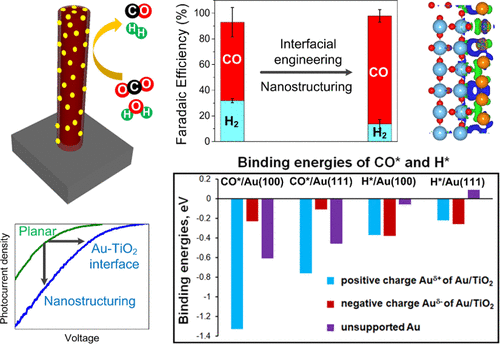当前位置:
X-MOL 学术
›
ACS Catal.
›
论文详情
Our official English website, www.x-mol.net, welcomes your
feedback! (Note: you will need to create a separate account there.)
Manipulating Intermediates at the Au–TiO2 Interface over InP Nanopillar Array for Photoelectrochemical CO2 Reduction
ACS Catalysis ( IF 11.3 ) Pub Date : 2021-08-31 , DOI: 10.1021/acscatal.1c02043 Guanyu Liu 1, 2 , Parvathala Reddy Narangari 3, 4 , Quang Thang Trinh 1, 2 , Wenguang Tu 1 , Markus Kraft 2, 5 , Hark Hoe Tan 4, 6 , Chennupati Jagadish 4, 6 , Tej S. Choksi 1, 2 , Joel W. Ager 7, 8 , Siva Karuturi 3, 4 , Rong Xu 1, 2
ACS Catalysis ( IF 11.3 ) Pub Date : 2021-08-31 , DOI: 10.1021/acscatal.1c02043 Guanyu Liu 1, 2 , Parvathala Reddy Narangari 3, 4 , Quang Thang Trinh 1, 2 , Wenguang Tu 1 , Markus Kraft 2, 5 , Hark Hoe Tan 4, 6 , Chennupati Jagadish 4, 6 , Tej S. Choksi 1, 2 , Joel W. Ager 7, 8 , Siva Karuturi 3, 4 , Rong Xu 1, 2
Affiliation

|
Photoelectrochemical (PEC) reduction of CO2 with H2O is a promising approach to convert solar energy and greenhouse gas into value-added chemicals or fuels. However, the exact role of structures and interfaces of photoelectrodes in governing the photoelectrocatalytic processes in terms of both activity and selectivity remains elusive. Herein, by systematically investigating the InP photocathodes with Au–TiO2 interfaces, we discover that nanostructuring of InP can not only enhance the photoresponse owing to increased light absorption and prolonged minority carrier lifetime, but also improve selectivity toward CO production by providing more abundant interfacial contact points between Au and TiO2 than planar photocathodes. In addition, theoretical studies on the Au–TiO2 interface demonstrate that the charge transfer between Au and TiO2, which is locally confined to the interface, strengthens the binding of the CO* intermediate on positively charged Au interfacial sites, thus improving CO2 photoelectroreduction to form CO. An optimal Au–TiO2/InP nanopillar-array photocathode exhibits an onset potential of +0.3 V vs reversible hydrogen electrode (RHE) and a Faradaic efficiency of 84.2% for CO production at −0.11 V vs RHE under simulated AM 1.5G illumination at 1 sun. The present findings of the synergistic effects of the structure and interface on the photoresponse and selectivity of a photoelectrode provide insights into the development of III–V semiconductor-based PEC systems for solar fuel generation.
中文翻译:

在 InP 纳米柱阵列上操作 Au-TiO2 界面的中间体用于光电化学 CO2 还原
用 H 2 O光电化学 (PEC) 还原 CO 2是将太阳能和温室气体转化为高附加值化学品或燃料的一种很有前景的方法。然而,就活性和选择性而言,光电极的结构和界面在控制光电催化过程中的确切作用仍然难以捉摸。在此,通过系统地研究具有 Au-TiO 2界面的 InP 光电阴极,我们发现 InP 的纳米结构不仅可以通过增加光吸收和延长少数载流子寿命来增强光响应,而且还可以通过提供更丰富的界面来提高对 CO 生成的选择性。 Au和TiO 2之间的接触点比平面光电阴极。此外,对 Au-TiO 2界面的理论研究表明,Au 和 TiO 2之间的电荷转移(局部限制在界面上)加强了 CO* 中间体在带正电的 Au 界面位点上的结合,从而改善了 CO 2光电还原形成 CO。最佳 Au-TiO 2/InP 纳米柱阵列光电阴极在模拟 AM 1.5G 光照下,相对于可逆氢电极 (RHE) 具有 +0.3 V 的起始电位和 84.2% 的法拉第效率,在 -0.11 V 与 RHE 条件下,CO 产生效率为 84.2%。目前关于结构和界面对光电极的光响应和选择性的协同效应的发现为开发基于 III-V 族半导体的太阳能燃料发电 PEC 系统提供了见解。
更新日期:2021-09-17
中文翻译:

在 InP 纳米柱阵列上操作 Au-TiO2 界面的中间体用于光电化学 CO2 还原
用 H 2 O光电化学 (PEC) 还原 CO 2是将太阳能和温室气体转化为高附加值化学品或燃料的一种很有前景的方法。然而,就活性和选择性而言,光电极的结构和界面在控制光电催化过程中的确切作用仍然难以捉摸。在此,通过系统地研究具有 Au-TiO 2界面的 InP 光电阴极,我们发现 InP 的纳米结构不仅可以通过增加光吸收和延长少数载流子寿命来增强光响应,而且还可以通过提供更丰富的界面来提高对 CO 生成的选择性。 Au和TiO 2之间的接触点比平面光电阴极。此外,对 Au-TiO 2界面的理论研究表明,Au 和 TiO 2之间的电荷转移(局部限制在界面上)加强了 CO* 中间体在带正电的 Au 界面位点上的结合,从而改善了 CO 2光电还原形成 CO。最佳 Au-TiO 2/InP 纳米柱阵列光电阴极在模拟 AM 1.5G 光照下,相对于可逆氢电极 (RHE) 具有 +0.3 V 的起始电位和 84.2% 的法拉第效率,在 -0.11 V 与 RHE 条件下,CO 产生效率为 84.2%。目前关于结构和界面对光电极的光响应和选择性的协同效应的发现为开发基于 III-V 族半导体的太阳能燃料发电 PEC 系统提供了见解。











































 京公网安备 11010802027423号
京公网安备 11010802027423号